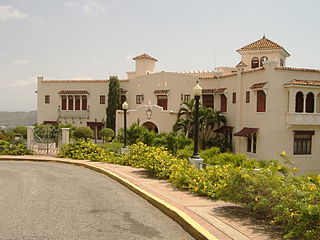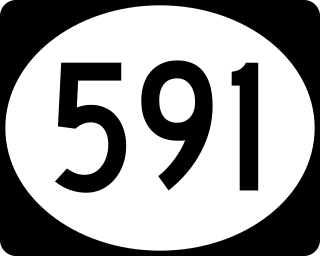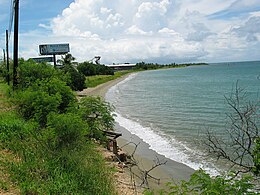
Ponce is a city and a municipality on the southern coast of Puerto Rico. The most populated city outside the San Juan metropolitan area, was founded on August 12, 1692 and is named after Juan Ponce de León y Loayza, the great-grandson of Spanish conquistador Juan Ponce de León. Ponce is often referred to as La Perla del Sur, La Ciudad Señorial, and La Ciudad de las Quenepas.

Mayagüez is a city and the eighth-largest municipality in Puerto Rico. It was founded as Pueblo de Nuestra Señora de la Candelaria de Mayagüez, and is also known as La Sultana del Oeste, Ciudad de las Aguas Puras, or Ciudad del Mangó. On April 6, 1894, the Spanish Crown granted it the formal title of Excelente Ciudad de Mayagüez. Mayagüez is located in the center of the western coast on the island of Puerto Rico. It has a population of 73,077 in the city proper, and it is a principal city of the Mayagüez Metropolitan Statistical Area and the Mayagüez–San Germán–Cabo Rojo Combined Statistical Area.

The University of Puerto Rico, Mayagüez Campus (UPRM) or Recinto Universitario de Mayagüez (RUM) in Spanish, is a public land-grant university in Mayagüez, Puerto Rico. UPRM is the second-largest university campus of the University of Puerto Rico system. In addition to its status as a land-grant university, it is also a member of the sea-grant and space-grant research consortia. In 2009, the campus population was composed of 12,108 students, 1,924 regular staff members, and 1,037 members of the education staff. In 2013, the student population remained relatively steady at 11,838, but the instructional faculty dropped to 684. In the second semester of 2019 around 12,166 students were enrolled. By the end of the academic year 2022-2023 there were 10,071 students enrolled. UPRM has been accredited by the Middle States Commission on Higher Education (MSCHE) since 1946.
Ernesto Ramos Antonini was the President of the House of Representatives of Puerto Rico and co-founder of the Partido Popular Democrático de Puerto Rico.

The Pontifical Catholic University of Puerto Rico is a private Roman Catholic university with its main campus in Ponce, Puerto Rico. It provides courses leading to Bachelor's, Master's and Doctorate degrees in education, business administration, the sciences, and arts and humanities. It also has campuses in Arecibo and Mayagüez, as well as a satellite extension in Coamo. It is also home to a School of Law and a School of Architecture. The university also founded a medical school, Escuela de Medicina de Ponce, in 1977, but in 1980 became an independent entity that eventually became the Ponce Health Sciences University.

Rail transport in Puerto Rico currently consists of a 10.7-mile (17.2 km) passenger metro system in the island's metropolitan area of San Juan. Its history can be traced back to the mid-19th century with the construction of a limited passenger line in Mayagüez. Between the late 19th and early 20th centuries, Puerto Rico's rail transport system expanded significantly, becoming one of the largest rail systems in the Caribbean at the time thanks to an economic boom in agriculture industries, especially the sugar cane industry. The rail system was expanded to include passenger travel with a direct line from the island's northern capital of San Juan to the western and southern cities and towns, greatly improving travel and communication within the island. However, the entire system was soon overshadowed by the arrival of the automobile, and by the 1950s was completely abandoned. Small remnants of this system still exist in some parts of Puerto Rico, some conserved for tourism purposes.

Puerto Rico Highway 2 (PR-2) is a road in Puerto Rico that connects the cities of San Juan and Ponce. At 156 miles (230 km) long, it is Puerto Rico's longest singled-signed highway.

Luis Antonio ("Wito") Morales Crespo was a Puerto Rican politician and Mayor of Ponce, Puerto Rico, from 1973 to 1976. He was also Senator for the District of Ponce from 1977 to 1980 and president of the Ponce Municipal Assembly from 1989 to 2004 He is recognized as a politician, sportsman, and sports broadcaster.

Canas is one of the 31 barrios in the municipality of Ponce, Puerto Rico. Along with Anón, Coto Laurel, Guaraguao, Quebrada Limón, Real, San Patricio, and Marueño, and the coastal barrio of Capitanejo, Canas is one of the municipality's nine bordering barrios. It borders the municipality of Peñuelas. Along with Playa, Bucana, Vayas and Capitanejo, Canas is also one of Ponce's five coastal barrios. It was founded in 1831.

Puerto Rico Highway 591 (PR-591) is tertiary highway in Ponce, Puerto Rico. The road is located at the El Tuque sector of Barrio Canas.

A balneario is an Iberian and Latin American resort town, typically a seaside resort, and less commonly along the shores of lakes and rivers or next to hot springs. In Spain, balneario typically only refers to spa town resorts. These resorts offer recreation, sports, entertainment, food, hospitality and safety services, retail, and cultural events. These balneario towns are characterized by being flooded by masses of tourists during the summer seasons.
The Grand Prix de Ponce is an auto race held at the Ponce Speedway in the El Tuque sector of barrio Canas, Ponce, Puerto Rico. The yearly event started in 1993. Before the construction of the Speedway, the race took place in the area of La Guancha in barrio Playa in Ponce. The new speedway opened in 2003.
The following is a timeline of the history of the city of Ponce, Puerto Rico.

The Complejo Recreativo y Cultural La Guancha is a recreational complex in barrio Playa in Ponce, Puerto Rico, with family recreational and cultural facilities that opened on 23 June 1998. The highlight of the complex is the Paseo Tablado La Guancha, which is flanked by a beach, an observation tower, an amphitheater, and 24 open-air kiosks. It was developed during the administration of Mayor Rafael Cordero Santiago. In October 2017, after Hurricane Maria, it closed to the public to undergo repairs but, as of January 2020, when the area suffered severe damage due to the 2020 Puerto Rico earthquakes, no repairs had been made and, as of 17 June 2020, it remained closed. By late 2020 arrangements were made for the merchants that operated from waterfront kiosks to reopen their businesses out of provisional facilities at a temporary location away from the waterfront while reconstruction of the waterfront area takes place.

Bahía de Ponce is a bay in Barrio Playa, Ponce, Puerto Rico. The Bay is home to the most important commercial harbor on the Puerto Rico south coast and the second largest in Puerto Rico. The Cardona Island Light is located on the Bay to mark the way into the Bay from the nearby Caja de Muertos Light.













